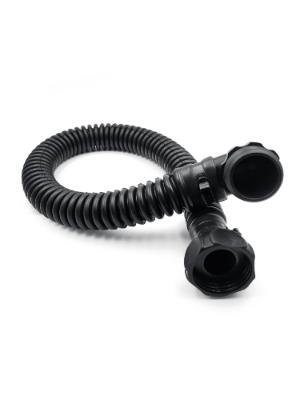How a Gas Mask with Hose Can Protect You in Hazardous Environments?
In the modern world, no matter the work environment (i.e., industrial workers, emergency responders, or individuals preparing for extreme survival), exposure to hazardous situations is constantly present. Toxic gases, chemical spills, smoke from fires, or airborne pathogens can impact your health in seconds and often can have serious consequences. Equipping yourself with the right, appropriate equipment is not just a choice—it is a requirement. One of the best tools for personal safety in these situations is a Gas Mask with Hose that provides filtered, clean air while providing maneuverability and extended comfort in dangerous situations.
Unlike traditional masks, a gas mask with a hose connects to an external air supply or a filtration system and provides a high level of protection against harmful substances. Gas masks with hoses are used not only by military personnel, they are also by firefighters, industrial workers, and safety enthusiasts looking for reliable protection in hostile environments. The knowledge of how these particular masks work, what makes them different, and in what conditions they work the best can mean the difference between life and death in toxic air quality situations.

Main Components and How They Function
-
Facepiece: The primary component that covers the eyes, nose, and mouth. The facepiece must provide a good facial seal to prevent unfiltered air from seeping in. Typical facepiece materials are silicone or rubber, which improve comfort and durability.
-
Hose: Connects the facepiece to either a filter or a remote air supply. The hose can be long enough and flexible enough to allow freedom of movement without being unplugged from the clean air source.
-
Filter or Air Supply Unit: The unit that removes toxic solids/particulates, gases, vapors, etc. Military hoses usually connect with NATO filters, which are effective in protecting from chemical, biological, and radiological agents.
-
Exhalation valve: Allow carbon dioxide to exit the mask without compromising the facepiece seal to outside air contaminants.
Through the use of these features, a Gas Mask with Hose creates an effective and controlled air flow system to provide clean air for breathing in hostile environments.
Protection Against Chemical Hazards
Chemical spills, industrial accidents, and exposure to hazardous fumes are among the most prevalent hazards in the workplace and emergencies. A gas mask with a hose provides a barrier against those most immediate threats by filtering out hazardous materials before they can enter the respiratory tract.
The hose allows the user to use a gas mask that filters air from a distance away, limiting exposure to concentrated hazardous chemicals and with high filtering capabilities, corrosive acids, alkalis, and other hazardous substances. Due to this filtering capability, Israeli gas masks for sale are essential for chemical plants, laboratories, and cleaning hazardous waste.

Defense in Biological Threat Scenarios
Biological agents, such as bacteria, viruses, and spores, can be airborne and highly contagious. A gas mask with a hose that is equipped with a HEPA (high-efficiency particle air) filter or comparable filtering system can capture small pathogen particles, therefore protecting the wearer from inhaling them.
In instances of hazardous exposures, such as during infectious outbreaks, lab research, or emergency response scenarios, gas masks with hoses provide continuous protection to the user while completing the critical task at hand. The use of this hose filtration system means the risk of contamination is lessened compared to an unrestricted use of a mask (a restriction might refer to a state in which a person is inhaling particulate through a normal regulation site), if an exposure to any hazards occurs.
Protection from Smoke and Particulate Matter
Thick smoke and fine particulate matter from fires, explosions, and construction are extremely harmful to the lungs. While regular masks may filter some particulates, a gas mask with a hose can filter more air quality and offer more protection by filtering the air from a clean supply.
Extended operational time, because the hose is affixed to a gas mask, is one benefit of having a hose-connected gas mask. You do not need to replace filters frequently. As long as there is a clean air supply through the hose, the amount of breathing you can do in the smoke is sufficient for the operation and safety of the rescuer or emergency responder.
Benefits of Using a Gas Mask with a Hose
-
Increased Breathing Safety: The hose accesses a larger filter or moves the air source from a distance, which extends your time of operation in potentially hazardous environments.
-
Flexibility/Mobility: Users can move with ease in confined spaces without concern for air quality.
-
Enhanced Protection: Although there are filters, or air is being pushed from a source outside the room or area, these provide greater protection from chemical, biological, and particulate matter.
-
Comfort: The design has less resistance to inhalation than regular gas masks or filters, making it easier to wear longer.
-
Military and Industrial Standard: Most products meet overseas standards indicated by NATO symbols, and OSHA standards when it comes to safety in extreme environments.
Final Words
Gas masks with hoses are an invaluable tool for anyone operating in hazardous environments, offering protection against chemical, biological, and particulate threats while maintaining mobility and comfort. Whether for industrial use, emergency response, or personal safety in extreme situations, these masks provide a reliable barrier between you and dangerous airborne hazards.
For those looking to invest in high-quality protection, the Gas Mask with Hose 40mm NATO Military Hose from Supergum Shop offers superior filtration, durability, and performance. Designed for professional and survival use, it ensures you breathe safely no matter the environment.


